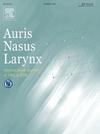Prediction model of ipsilateral level II lymph node metastasis in papillary thyroid carcinoma
IF 1.5
4区 医学
Q2 OTORHINOLARYNGOLOGY
引用次数: 0
Abstract
Objectives
This study aimed to develop a predictive model for ipsilateral level II lymph node metastasis (LNM) in patients with papillary thyroid carcinoma (PTC) using machine learning techniques. The necessity of level II dissection in lateral neck dissection (LND) remains debated, and accurate prediction of metastasis at this level could help refine surgical decision-making and minimize unnecessary dissection.
Methods
A retrospective review of 138 patients with PTC who underwent initial LND with curative intent was performed. Preoperative patient background and imaging findings were analysed to identify factors associated with ipsilateral level II LNM. Decision trees (DT), random forests (RF) and support vector machines (SVM) were trained using a 70:30 data split and 10-fold cross-validation. Model performance was assessed using area under the receiver operating characteristic curve (AUC) and Brier score.
Results
Ipsilateral level II LNM was present in 55 patients (39.9 %); the DT model identified significant predictors: level II LNM ≥15 mm, multiple level III lymph nodes suspicious for metastases preoperatively (LNSM), superior pole extension, level III/IV LNSM <18 mm (AUC: 0.831, Brier score: 0.140). RF and SVM showed improved predictive performance (RF: AUC 0.901, Brier score 0.124; SVM: AUC 0.929, Brier score 0.110). Features of high importance in RF and SVM were similar to those in DT.
Conclusions
This study highlights the potential of machine learning-based models in predicting ipsilateral level II LNM in PTC patients and contributes to a more personalized approach to LND. The findings support the selective omission of ipsilateral level II dissection in carefully evaluated cases, which may reduce surgical morbidity without compromising oncologic outcomes.
甲状腺乳头状癌同侧II级淋巴结转移的预测模型。
目的:本研究旨在利用机器学习技术建立甲状腺乳头状癌(PTC)患者同侧II级淋巴结转移(LNM)的预测模型。在侧颈剥离(LND)中进行II级剥离的必要性仍然存在争议,准确预测该水平的转移可以帮助改进手术决策并减少不必要的剥离。方法:对138例首次行LND治疗的PTC患者进行回顾性分析。分析术前患者背景和影像学结果,以确定与同侧II级LNM相关的因素。决策树(DT)、随机森林(RF)和支持向量机(SVM)使用70:30的数据分割和10倍交叉验证进行训练。采用受试者工作特征曲线下面积(AUC)和Brier评分评估模型性能。结果:55例(39.9%)患者出现同侧II级LNM;DT模型确定了显著的预测因素:II级LNM≥15 mm,术前怀疑转移的多个III级淋巴结(LNSM),极延长,III/IV级LNSM。结论:本研究强调了基于机器学习的模型在预测PTC患者同侧II级LNM方面的潜力,并有助于更个性化的LND方法。研究结果支持在仔细评估的病例中选择性省略同侧II级解剖,这可能会减少手术发病率而不影响肿瘤预后。
本文章由计算机程序翻译,如有差异,请以英文原文为准。
求助全文
约1分钟内获得全文
求助全文
来源期刊

Auris Nasus Larynx
医学-耳鼻喉科学
CiteScore
3.40
自引率
5.90%
发文量
169
审稿时长
30 days
期刊介绍:
The international journal Auris Nasus Larynx provides the opportunity for rapid, carefully reviewed publications concerning the fundamental and clinical aspects of otorhinolaryngology and related fields. This includes otology, neurotology, bronchoesophagology, laryngology, rhinology, allergology, head and neck medicine and oncologic surgery, maxillofacial and plastic surgery, audiology, speech science.
Original papers, short communications and original case reports can be submitted. Reviews on recent developments are invited regularly and Letters to the Editor commenting on papers or any aspect of Auris Nasus Larynx are welcomed.
Founded in 1973 and previously published by the Society for Promotion of International Otorhinolaryngology, the journal is now the official English-language journal of the Oto-Rhino-Laryngological Society of Japan, Inc. The aim of its new international Editorial Board is to make Auris Nasus Larynx an international forum for high quality research and clinical sciences.
 求助内容:
求助内容: 应助结果提醒方式:
应助结果提醒方式:


